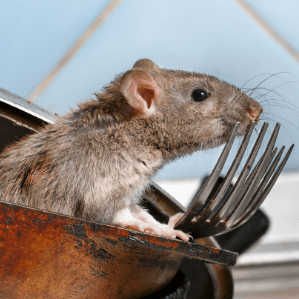So you’re seeing signs of rodent activity in your Long Island home—some droppings here, some chewing there, a bit of gnawed-up wood, and maybe a few strange noises, but how do you know which type of pest you’re dealing with? Could it be mice, or worse…rats?!
We’re going to hook you up with all the information you need to help you determine what sort of pest has made its way into your home, offer our advice for what to do about it, and even let you in on a few secrets that will help prevent future rodent issues.
Do I Have Mice or Rats? 
One of the easiest ways to determine whether or not you’re dealing with a mouse problem or a rat problem is to catch your intruder in the act, and determine what the little (or big) critter looks like. Here are some basic traits of commonly spotted Long Island rodents:
The Deer Mouse
Deer Mice are a common species of rodents Long Island homeowners deal with. These small critters measure about 5.5-7 inches long, including their tails. They’re often gray, brown, or black, and have a distinct pattern on their fur that looks similar to that of a deer, as well as white feet! They’re fast and agile, which adds to their similarities with deer.
The House Mouse
As for the House Mouse, which is another very common rodent on Long Island, these mice are slightly larger than Deer Mice and are usually around 5-8 inches in length including their tails. House Mice are generally brown and white, with large ears and tails covered in a light layer of velvety fur. They also have distinctly small, beady, and black eyes.
…And the Norway Rat
The Norway rat, Long Island’s most commonly spotted rat in homes has a blunt nose, as well as small ears and eyes. Adult Norway Rats have a body length of 7- 9 ½ inches and a tail length of 6-8 inches. The Norway rat’s tail is dark-colored on top and lighter-colored underneath. They have coarse hair that is brown and scattered with black hair, while their bellies and undersides are a lighter white shade.
Signs of Rats or Mice in Your Home
Aside from their different physical characteristics, there are also signs of rodent activity that you’ll likely see throughout your home which are clear indicators of whether or not you’re dealing with mice or rats.
Differences Between Rat and Mouse Poop
Mouse Droppings
Mouse droppings are small (less than ¼ inch long), dark, and pointed on both ends. You may find these droppings near food packages, in drawers or cabinets, or under your kitchen or bathroom sinks, where they may leave you up to 100 surprises per day.
Rat Droppings
Larger pests = larger poop. Rat droppings are similar, brown in color, though noticeably larger than those of mice. Norway Rats will usually leave up to 50 droppings per day. If you find droppings in your home that are around ½ inch long, it’s very likely you’re dealing with a rat problem.
What Has the Pest Been Munchin’ On?
What Do Mice Eat?
Given a choice, mice would like to chow down on sweets, cereals, grains, and dried fruits! Research also states mice prefer to eat peanut butter, chocolate, hazelnut spread, and other sweets to cheese, which they’re commonly associated with.
What Do Rats Eat?
Norway Rats often feed on a variety of food sources high in protein, including other rodents, dead animals, fish, meat scraps, pet food, and other assorted foods like fruits, grains, and nuts that they find.
Where is the Rodent Issue?
Where Do Mice Hide?
House Mice are commensal rodents, which means that throughout time, they’ve become partially reliant on humans for their basic needs—food, water, and shelter. Because of this, House Mice are most often found nesting inside the walls of Long Island homes, up in attics, down in basements and crawl spaces, and even behind large home appliances like refrigerators.
Where Do Rats Hide?
Norway Rats are notoriously bad climbers, so they’re most often found on ground levels of Long Island homes and other buildings. They like to live and nest near humans to keep in close proximity to food sources, which is why they’re frequently found in basements, ground-level floors, under piles of debris, and inside crawl spaces.
Rats or Mice in Your House? Call Suburban Exterminating Now!
To protect your home, family, and pets from mice this fall and winter, choose Suburban Exterminating to keep mice and rats out before they get in. And as always, if you need help determining how to tell if you have rats or mice, our team of experts are here to help contact us today!

